Residential and Commercial Heating Systems
When it comes to upgrading or replacing your heating system, be aware that furnaces generally last about 15 to 20 years. So if you’ve purchased a home with an older furnace, you may find it doesn’t run very efficiently and you will likely have to replace and install a new one very soon.
New Heating System Options for Your Home or Office
If your furnace has surpassed its recommended lifespan and your utility bills are rising, or it’s costing you more in repairs than 50% of purchasing a brand-new furnace, you should consider contacting our experienced heating professionals as soon as possible to discuss new heating system options.
Lancaster Heating and Cooling will help you find the perfect solution. Working closely with the world leaders in heating technology, Trane and Carrier, we provide the highest quality heating systems. Our products include Trane furnaces and Carrier furnaces, Trane and Carrier Heat Pumps and Ductless systems. All are covered by one of the best warranties in the business.

As a leader in heating solutions, Carrier constantly builds upon its history of quality.
Carrier Furnaces
Trane heating products are detail-designed and rigorously tested for reliability and durability.
Trane Furnaces
Heating Services Near Hamilton, ON
Let’s face it, Hamilton’s winters can be brutal. We provide customers with technicians who have received extensive training to ensure our customers’ comfort and confidence. With your comfort as a top priority, you can count on Lancaster to properly install new and efficient gas furnaces, heat pumps, ductless split systems, and many more heating options. Our dedicated team of professional technicians and installers have the solutions to solve all your heating needs.The comprehensive heating services we offer:
- Ductless mini-split system installation and service
- Heat pump installation and service
- Energy-efficient furnace installation and service
- Yearly equipment maintenance and service
- 24-hour emergency service
- Commercial heating
- Fireplace installation and service
Contact Your Trusted Heating Systems Professionals
Schedule a free estimate with the experienced heating system professionals at Lancaster. We can answer all your questions about finding a more energy-efficient system for your residential or commercial property. Our factory-trained technicians will ensure your new heating system is installed correctly to last its full lifespan.
Heating Systems FAQs
What is two-stage heating?
Two-stage heating means the furnace has two levels of heat output: high for cold winter days, and low for milder days. Since the low setting is adequate to meet household heating demands 80% of the time, a two-stage unit runs for longer periods and provides more even heat distribution.
What is AFUE?
Your furnace’s AFUE, Annual Fuel Utilization Efficiency, percentage tells you how much energy is being converted to heat. For example, an AFUE of 90 means 90 percent of the fuel is being used to warm your home, while the other 10 percent escapes as exhaust with the combustion gases.
What is variable speed technology?
“Variable speed” refers to the fan motor inside the air handler: the indoor part of an air conditioner that moves cooled or heated air throughout the ductwork of your home. An air handler is usually a furnace or a blower coil. Unlike conventional single-speed motors, a variable-speed motor runs at a wide range of speeds to precisely control the air throughout your home.
